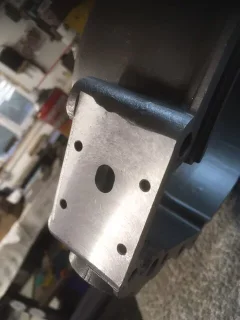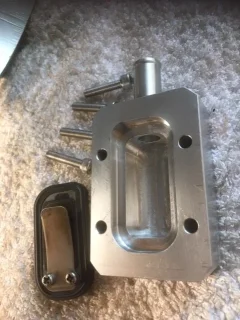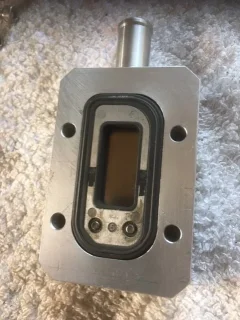https://www.triumphrat.net/cdn-cgi/...t/attachments/img_20230424_162225-jpg.810696/ With a Yamaha reed valve two inches away, between engine and trans, makes a low cost crank case vent.
Join the Access Norton Community
- Thanks for visiting Access Norton
- 3 free views left
- Create a free account (more details)
- Already a member? Click here to login
You are using an out of date browser. It may not display this or other websites correctly.
You should upgrade or use an alternative browser.
You should upgrade or use an alternative browser.
CCV with Yamaha reed valve two inches away makes a low cost CC vent.
- Thread starter rweb
- Start date
- Status
- Not open for further replies.
I used a one and a half inch long hose to connect to the Yamaha valve standing up between the engine and trans. Mine is about even with the frame rails or at least an inch more ground clearance than the commercially available ones and a few hundred dollars less expensive, for those that like to tinker.
ashman
VIP MEMBER
- Joined
- Jul 11, 2010
- Messages
- 6,460
Mine is connected by a hose just enough to mount on the breather outlet it sit in between my rear engine mounts and tucks away neatly and the outlet hose goes into my catch bottle which also sits behind the Gearbox/ rear engine mount as I have room there with the Featherbed frame, been like this for over 15 years and works a treat for venting.
You can just see it as well the catch bottle in this pic, I don't run my breather hose to the oil tank, the breather hose sit right to the bottom of the catch bottle and is vented from the top of the catch bottle where the cap use to screw on, I been using a catch bottle for over 40 years now.

You can just see it as well the catch bottle in this pic, I don't run my breather hose to the oil tank, the breather hose sit right to the bottom of the catch bottle and is vented from the top of the catch bottle where the cap use to screw on, I been using a catch bottle for over 40 years now.
- Joined
- Nov 11, 2013
- Messages
- 5,411

PCV Reed Valve - Crankcase Breather
Color/Finish: Silver Material: Metal Dimensions: Overall Length: 86.50mm Width (at widest point): 28.85mm Engine Inlet OD: 14.15mm Engine Inlet 11.85mm Filter (Air) Outlet OD: 12.00mm Filter (Air) Outlet ID: 9.45mm Fits: Universal Note: Easy Installation (Linked Below)
SteveBorland
VIP MEMBER
- Joined
- Nov 15, 2010
- Messages
- 978
I did a variation using a short threaded 90 degree hose barb, with a hole drilled through the rear wall of the crankcase. A short hose connects this to the Yamaha PCV valve which then runs back to the oil tank. Seems to work well, clearing a wet sump in a moment.
olympus
VIP MEMBER
- Joined
- Aug 5, 2017
- Messages
- 1,497
i purchased mine from HNW and fitted it onto a short hose from the OE breather body, i purposely mounted it as low as possible to maintain as much heat in as possible to avoid the dreaded emulsified oil/ condensation sludge from forming.
So far so good on the contamination front, and the valve works far better than i ever imagined it would
So far so good on the contamination front, and the valve works far better than i ever imagined it would
Last edited:
baz
VIP MEMBER
- Joined
- May 26, 2010
- Messages
- 8,558
On my 750 I mounted the yam pcv unit on a plate where the ill fated electric start was going to fit on the back of the timing cover to avoid emulsificationi purchased mine from HNW and fitted it onto a short hose from the OE breather body, i purposely mounted it as low as possible to maintain as much heat in as possible to avoid the dreaded emulsified oil/ condensation sludge from forming.
So far so good on the contamination front, and the valve works far better than i ever imagined it would
One day I will make a sump conversion as kommando has done
Where did you put yours Steve? I know where I'd put it.Have you any idea how many threads on here cover that subject to death!
Here is the bottom view. click here
- Joined
- Dec 20, 2011
- Messages
- 3,478
I can assure you, it won't fit! The thread is all wrong!Where did you put yours Steve? I know where I'd put it.
Fast Eddie
VIP MEMBER
- Joined
- Oct 4, 2013
- Messages
- 22,700
Now THAT’S what I call a crank nut !!
- Joined
- Dec 20, 2011
- Messages
- 3,478
It's what I call a tool!Now THAT’S what I call a crank nut !!
Broached for the keyway, it allows you to rotate the engine in either direction doing timing etc. Even when valves and springs and timing cover are fitted.
And you can also to hold the crank when removing or refitting the oil pump worm. I prefer this to a tommy bar through my bushless JSM Carrillo rods, or wood under the pistons, or any number of precarious alternatives.
Size dictated by available hex stock and the Land Rover hub nut socket I already had!
Matchless
VIP MEMBER
- Joined
- Dec 23, 2010
- Messages
- 1,281
I'm on with rebuilding my early 750 Commando engine back to stock, but with one exception. Reed valves work so well that I like to fit them to every build. This time I have used a reed from a modern Triumph triple in an aluminium housing. The only downsides are you need a milling machine & the motor has to be apart.
Attachments
Fast Eddie
VIP MEMBER
- Joined
- Oct 4, 2013
- Messages
- 22,700
That’s impressive !
- Joined
- Dec 20, 2011
- Messages
- 3,478
You don't just need a milling machine, you need to know how to use it. That is very neat, great work.I'm on with rebuilding my early 750 Commando engine back to stock, but with one exception. Reed valves work so well that I like to fit them to every build. This time I have used a reed from a modern Triumph triple in an aluminium housing. The only downsides are you need a milling machine & the motor has to be apart.
- Status
- Not open for further replies.






